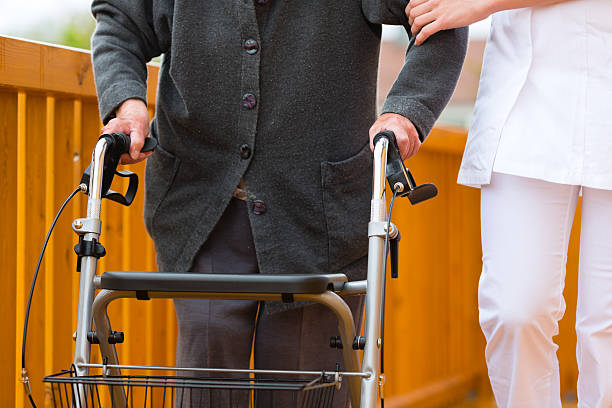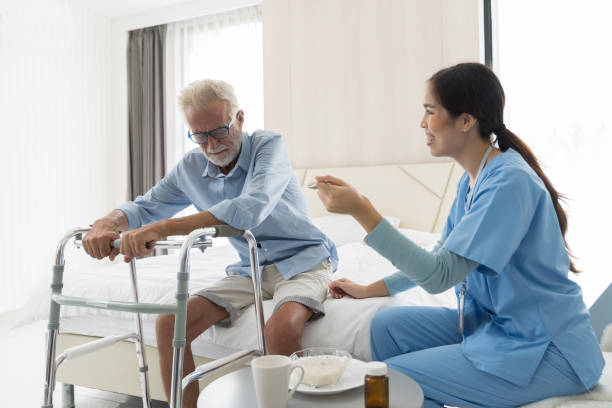Introduction

Living with Parkinson's disease can take a toll on a person's overall well-being and quality of life. If you or someone you know has been experiencing a gradual decline in health, you may have experienced this firsthand. Exercise is an important tool for managing symptoms and slowing progression; scientific evidence now points to physical activity as one essential component in reducing harm due to Parkinson's.
By understanding more fully how exercise affects those diagnosed with the disease, we can help people develop the best possible plan for staying healthy and maintaining their independence. This blog post will examine the research on how physical activity can potentially slow down the progression of a certain condition.
What is physical activity?
Physical activity, also known as exercise or movement, is any bodily activity that enhances or maintains physical fitness and overall health. It can range from simple daily activities like walking and going upstairs to more intense forms of exercise such as running and playing sports. Physical activity has many benefits for adults and children, including improved strength and endurance, better balance, reduced risk for certain diseases, improved mental health, and increased energy.
What is the role of physical activity on Parkinson's disease progression?

Physical activity has long been linked to improved physical and mental health. Studies have shown that physical activity may help slow down the advancement of Parkinson's disease. Regular exercise may help improve motor symptoms such as tremors, slowness, stiffness, balance, and gait.
Physical activity can positively impact well-being, potentially decreasing the risk of depression and anxiety. Engaging in endurance exercises like walking, cycling, and swimming can enhance cardiovascular health, which might aid in managing PD symptoms. Additionally, there is some evidence that strength training can improve motor function in people with PD.
It's important to remember that physical activity's benefits on PD progression are still being studied, and everyone's situation is different. Before starting any new exercise routine, it is important to seek advice from your doctor or a specialist in Parkinson's disease. By carefully monitoring symptoms and consulting with a physician regularly, people living with PD can find an exercise regimen that works best for them.
By engaging in physical activity, people with PD can improve their quality of life and potentially slow disease progression. Improved cardiopulmonary fitness, mobility, strength, and balance are all achievable through an appropriate exercise program tailored to the individual's needs. With regular exercise and a healthy lifestyle, individuals living with Parkinson's can maintain or even improve their overall well-being.
Effects of Exercise on Parkinson's Disease: A Meta-Analysis of Brain Imaging Studies
Studies have found that physical activity can help slow the progression of Parkinson's disease (PD). Exercise improves mobility and reduces depression and anxiety associated with the disease. Recent research has even suggested that exercise may directly impact brain structure and function in PD patients. In this review, we will analyze existing scientific evidence regarding the impact of physical activity on Parkinson's disease progression, focusing specifically on brain imaging studies.
Studies using magnetic resonance imaging (MRI) have shown that regular exercise can lead to structural and functional changes in the brain of PD patients. For instance, a study conducted by Wang et al. found that aerobic exercise can increase gray matter volume in the prefrontal cortex, which is associated with improved motor control. Additionally, another study by Lee et al. revealed that aerobic exercise can lead to increased functional connectivity between the frontal and temporal lobes in patients with PD. This suggests that physical activity may improve cognitive function in PD patients.
In addition to MRI studies, electroencephalography (EEG) studies have also found evidence that exercise can improve brain function in PD patients.
For example, a study conducted by Wang et al. showed that exercise could lead to decreased alpha wave activity in the brains of PD patients. This suggests that exercise may help reduce symptoms associated with cognitive deficits in the disease.
Overall, the current scientific literature provides strong evidence that physical activity can slow down the progression of PD by influencing brain structure and function. Exercise may be beneficial for improving mobility and cognitive function in patients with Parkinson's disease. Future research should focus on further evaluating these findings to develop more targeted exercise regimens for PD management.
Fighting Parkinson's Disease with Exercise and Diet

Regular physical activity can help slow the progression of Parkinson's disease and improve quality of life.
Here are some ways exercise and diet have a positive impact on Parkinson's:
-
Exercise helps with everyday activities such as walking, maintaining balance, and reducing fatigue.
-
Exercise increases strength, flexibility, mobility, and coordination.
-
Eating a healthy diet can support the body's natural inflammation-fighting abilities.
-
Plenty of fruits and vegetables provide essential nutrition to help manage Parkinson's symptoms.
-
Regular physical activity increases dopamine production, which helps regulate movement and reduce tremors.
-
Exercise contributes to improved cognition, mood, and sleep quality.
-
A healthy diet helps manage weight and reduces the risk of developing other chronic diseases.
Examples of physical activities for Parkinson's disease patients
Physical activity can be an effective way to manage Parkinson's disease symptoms. Examples of physical activities that may be beneficial include:
-
Exercises that focus on balance, such as tai chi or Pilates
-
Aerobic exercises like walking, biking, or swimming
-
Strength training with weights or resistance bands
-
Yoga and stretching to improve flexibility and mobility
Precautions for people with Parkinson's disease
There are some safety measures that people with Parkinson's disease should take to protect themselves.
-
The first of the most important precautions is limiting physical activity, as this can be physically and mentally taxing for those with the condition. It is recommended to avoid activities involving balance or coordination, such as ascending ladders or engaging in sports.
-
Second, being aware of the medication's various side effects is important. Common side effects include dry mouth, drowsiness, and blurred vision. If any of these occur, people should contact their doctor right away so they can adjust the dosage or switch medications if needed.
-
Third, as Parkinson's disease can cause difficulty with movement and coordination, it is important to take extra safety measures when driving. This includes avoiding night driving, limiting trips in unfamiliar areas, and being aware of any obstacles that might be in the way.
-
Finally, people with Parkinson's should stay up-to-date on their medical appointments. Regular check-ups, including tests to assess balance and coordination, will help ensure that any changes in the condition are caught quickly.
-
By taking these safety precautions, people with Parkinson's disease can stay safe and healthy. It is important to speak with your doctor about any questions or concerns. Your healthcare provider will be able to provide personalized advice and guidance on how best to manage the condition.
How to Manage Stiffness, Balance Problems, and Other Challenges During Exercising with PD
Exercise can greatly improve overall health, but it can pose particular challenges for people with Parkinson's Disease (PD). Exercising often exacerbates stiffness, balance problems, and other motor skill impairments.
However, some strategies can help manage these difficulties and promote safe exercise.
Proper warm-up and stretching exercises can help reduce stiffness and improve range of motion. Gentle stretches can also help improve balance by increasing flexibility in the muscles that support posture and coordination. It is important to consult your doctor before starting any exercise program to determine a suitable warm-up routine for your safety.
Because people with PD are particularly prone to falls, it is important to take the necessary precautions. People with PD should wear comfortable clothing and appropriate footwear that provides good support. Exercises should be done in a familiar setting with sufficient room and a stable surface free of hazards. It may also help to use a stationary or adjustable height exercise bench.
If an individual experiences fatigue, tremors, and lack of coordination while exercising, they may consider using assistive devices such as canes or walkers. In addition, working out with a partner or exercise group provides the motivation and support needed to ensure consistency in an exercise routine.
Ultimately, it is important to recognize that everyone's experience with PD is different. Finding the right exercise routine and modifying it as needed can help ensure that individuals stay safe while reaping the many health benefits of physical activity.
By following these tips, you can get started on a program tailored to your specific needs and limitations. Above all, remember to listen to your body and consult your doctor about any concerns. With the right exercise plan and proper precautions, individuals with PD can enjoy all the benefits of physical activity.
FAQ's
What worsens Parkinson's disease?
The cause of Parkinson's disease is not fully understood; however, several factors are known to worsen its progression. These factors include aging, exposure to environmental toxins, genetic mutations, and lifestyle behaviors. One such lifestyle behavior that has been increasingly studied for its impact on Parkinson's disease progression is physical activity. Research suggests regular physical activity can improve motor functioning and delay disease progression.
What calms Parkinson's?
What calms Parkinson's symptoms is difficult to answer as the disorder affects individuals differently. However, research has suggested the potential benefits of physical activity for those with Parkinson's disease. Physical exercise beneficial improve muscle strength, balance, gait, and coordination. It also helps with cognitive impairment functioning and reduces stress levels, benefiting those with the disorder.
What stops Parkinson's tremors?
Currently, no treatment is available that can completely stop tremors caused by Parkinson's disease. However, treatments such as medication, deep brain stimulation, and physical activity may help reduce the severity of the tremor or improve other motor symptoms associated with the disorder. According to research, regularly engaging in physical activity can improve motor function and potentially lessen the severity of tremors.
What kills neurons in Parkinson's disease?
The cause of death in neurons in Parkinson's disease is unknown. Some theories suggest the death of neurons may be due to a combination of genetic mutations and environmental toxins or lack of protection from neuroprotective factors such as physical activity. Research suggests that regular exercise can improve motor functioning and slow Parkinson disease progression by protecting existing neurons.
What deficiency causes Parkinson's?
The exact cause of Parkinson's disease is still unknown. However, evidence suggests that a combination of genetic mutations and environmental toxins may play a role in the development of the disorder. Research suggests that lack of physical activity can increase the risk and accelerate the progression of Parkinson's.
What decreases in Parkinson's disease?
Parkinson's disease gradually impacts a person's ability to move and coordinate their movements. Over time, individuals living with Parkinson's may experience a decrease in their ability to move or walk normally. Other symptoms of the condition may include tremors, muscle stiffness, and slowed movement.
Conclusion
In conclusion, physical activity in Parkinson's progression cannot be overstated. Exercise can help improve motor functioning and reduce symptoms associated with the disorder. It can also delay the clinical progression of PD by protecting existing neurons and reducing stress levels. Therefore, it is important for individuals living with Parkinson's to consult their doctor about an appropriate exercise plan tailored to their needs. With the right precautions and exercise plan, individuals with PD can enjoy all the benefits of physical activity.

